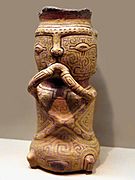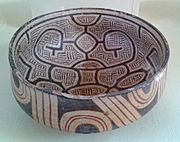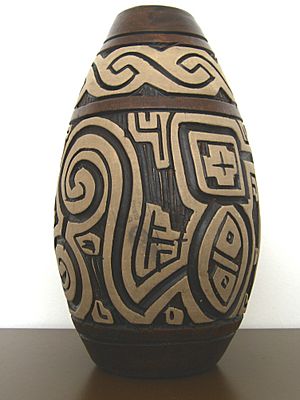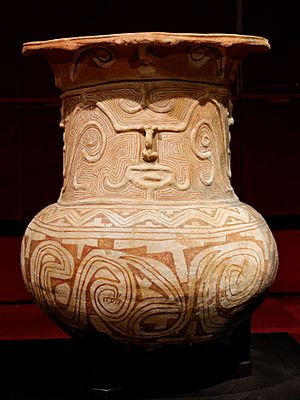Marajoara culture facts for kids
|
||||
The Marajoara or Marajó culture was an ancient civilization that lived on Marajó Island in Brazil. This island is located at the mouth of the Amazon River. Experts believe this culture thrived between 800 AD and 1400 AD. However, there is also evidence of people living there as early as 1000 BC. The Marajoara culture lasted in different forms until about 1600 AD.
Contents
Discovering the Marajoara Culture
Archeologists have found amazing pottery on Marajó Island. These pottery pieces are often large and have beautiful paintings and carvings of plants and animals. These discoveries were the first clues that a complex society once lived on Marajó.
The people also built large mounds of earth. These mounds suggest that many people lived together in organized settlements. Building such big earthworks would have needed a lot of planning and effort from a large community.
For a long time, experts disagreed about how complex the Marajoara culture was. In the 1950s, archeologist Betty Meggers thought the society came from the Andes mountains. But in the 1980s, another archeologist, Anna Curtenius Roosevelt, studied the mounds. She concluded that the Marajoara society developed right there on the island.
Some studies suggest the Marajoara culture might have had a population of up to 100,000 people. They may have used a special type of rich soil called terra preta. This soil helped them grow enough food to support such a large population. It also helped them create complex societies, possibly with chiefdoms, which are like small kingdoms led by chiefs.
How the Mounds Were Built
Scientists now think the large Marajoara mounds, called tesos, were not built entirely by hand. The people likely used natural high areas that were already there. Then, they added more earth on top to create their structures. This means they used less effort than if they had built the mounds from scratch.
The earliest signs of human activity and mound building on Marajó Island are from a time called the 'Ananatuba phase'. The Castanheira site from this period is an example of an artificial mound.
Food and Trade
The Marajoara people ate a variety of foods. They relied a lot on small seeds and small fish. They might have grown these seeds or protected them. Many of the burnt seeds found have not been identified yet. They seem to be from local grasses. Trees like the açai and tucuma palms were also important for food. These palms were also used to make things like baskets and canoes.
Studies of human bones show that the Marajoara people did not eat many starchy root crops like manioc. Instead, their teeth show they ate mostly seeds, tree fruits, and fish. Since there were many small fish and few land animals, they focused on catching fish. They probably caught fish by stunning them with a poisonous plant called liana. This made the fish float to the surface, making them easy to collect. This method worked best during the dry season when fish were trapped in smaller streams.
The Marajoara people used stone axes for farming. Archeologists have also found rare stone griddles, which are flat cooking surfaces. The scarcity of these griddles suggests that root crops were not a main part of their diet.
The earthen mounds were very important. They were used as cemeteries and places to live. This was because the low-lying areas of the island often flooded during the rainy season. The mounds might have also helped protect them from enemies. The Marajoara people may have also built ramps, canals, and drained fields. However, much of this evidence is now buried by mud from floods.
The Marajoara people traded with others. They needed to import stone because Marajó Island does not have good sources of rock. The stone artifacts found are mostly made from a green, dark rock. This type of stone is often found in Mesoamerica, which might be where Marajó got its imported stone.
Over time, the Marajoara people started making more complex and special pottery for ceremonies. This suggests that making pottery became a specialized job. However, later in the Marajoara period, this specialization in pottery making seemed to decline.
Homes and Settlements
Most archeological digs on Marajó Island have focused on the largest earthen mound sites. But there were likely many more smaller mounds and places where people lived without mounds.
The settlements were organized in different sizes:
- There were 3 to 4 very large sites with many mounds, like Os Camutins with 40 mounds. These sites could hold thousands of people. For example, Os Camutins had about 10,000 people.
- Many smaller sites had 3 to 5 mounds each, like Monte Carmelo.
- Numerous single mound sites, like Teso do Sitio. These housed a few hundred to about a thousand people.
- Countless low-mound and non-mound sites.
The mounds were built in the lowest areas, which were most likely to flood. They were made of earth and even garbage was used to fill them.
The mounds had many uses. They were used as cemeteries, homes, and for defense against enemies and floods.
The homes on the mounds were similar to present-day malocas, which are longhouses in the Amazon. These were homes for several families. Each family likely had its own cooking area, or hearth, lined up in the middle of the building. The malocas were built from earth, wooden poles, and thatch roofs. People lived in these homes for a long time, building new structures on top of old ones. At some places, like Os Camutins, up to 20 layers of homes were found. They had permanent cooking areas made of baked clay and plastered floors, which were often repaired.
There were also large earthworks, causeways (raised roads), ramps, canals, and drained fields. These have mostly been buried by mud from floods.
Tools and Art
When travelers visited Marajó in the 1800s, they noticed the mounds and the beautiful pottery found inside them. Museums in Europe and the United States started collecting these pieces. The largest and most beautiful pieces were often funerary urns. These urns were buried in the floors of houses built on top of the mounds. They held the bones of important people. After someone died, their bones were cleaned and placed in these decorated urns, which were then covered with a bowl or platter.
The Marajoara people made many different items. These included pottery vessels like urns, jars, bottles, cups, bowls, plates, and dishes. They also made figurines, large statues, pendants, ear and lip jewelry, whistles, and small ceramic models of tools like axes and hammers. Stone tools were very rare because there was no good stone on Marajó Island. The few stone items found might have been special gifts or used for making crafts.
Fancy pottery was found in garbage piles between houses and in graves. But around cooking areas, only plain, everyday pottery was found. Also, the smaller mound sites had very little fancy pottery. Some items were only found at certain sites. For example, Teso dos Bichos had thousands of small ceramic and sandstone tools for smoothing things, which were rare elsewhere.
Overall, the pottery and other items from the Marajoara culture became more complex and specialized over time. But later in the Marajoara period, this complexity and specialization seemed to decrease.
Leaders and Society
It's not fully clear how the Marajoara society was organized. Some things suggest there were different social classes, but it's hard to tell if this was based on gender or wealth. The large mounds, big multi-family homes, and complex crafts often suggest a society with strong leaders and different social levels. However, this is not always true.
The art of the Marajoara people does not show a single, powerful ruler. Instead, it suggests that social status might have been passed down through the mother's family.
Studies of skeletons also show some differences among people. Some individuals were taller and had better nutrition, while others were shorter and ate less well. Some well-fed skeletons also showed signs of skull shaping, which might point to an elite class. More research is needed to fully understand these differences.
There is also evidence that women might have had a lower status than men in some ways. But other evidence suggests women were more important and had higher status than women in the Amazon today. For example, women are shown often in Marajoara art as creators or important ancestors. Homes were also likely matrilocal, meaning husbands moved into their wives' homes. Women were also important in producing food. Ancient Amazonian stories often talk about societies where family lines were traced through women, starting from a mythical female ancestor. These stories also suggest women had high social status and important political or religious roles.
The fact that few female skeletons are found in elaborate burial urns might suggest lower status for women. However, important women do not always hold political power, so their absence from fancy burials doesn't automatically mean they had low status.
Plain pottery was mostly used for daily tasks, while fancy pottery was found in graves and garbage, not around cooking areas. This could mean women mainly made and used plain pottery, while men controlled the fancy ceremonial pottery. But the real link between pottery and social rank is still being studied.
Beliefs and Spirituality
We don't fully understand the Marajoara people's belief system. But it seems that important female figures were central to their religion. Their art shows women with special spiritual powers, like shamans. This fits with societies that trace their family lines through a mythical female ancestor.
Their beliefs might have been similar to other Amazonian cultures. These cultures often see the universe as divided by gender, with men linked to the sun and women to the moon. Ancient female creators in Amazonian stories might be shown in Marajoara art. The way Marajoara settlements were built, aligned east-to-west, also fits with a gender-divided universe. It's possible that ancestor worship was very important, as deceased people were placed in urns and buried in the mounds where people lived.
Burial Practices
The most common way to bury the dead was in burial urns. These urns often contained special items like stone tools and fancy pottery. The bones inside the urns were well preserved because they were covered with clay soil. Few female skeletons have been found so far.
While the exact causes of death are not known, the available skeletons show that the Marajoara people were generally healthy and well-fed compared to people in the Amazon after Europeans arrived. Even though Marajoara cemeteries are important and easy to dig up, only a few have been fully studied.
Fighting and Conflict
While skeletons haven't been fully checked for injuries from fighting, they show unusual muscle development. This strongly suggests that the Marajoara people regularly practiced for warfare. The muscle patterns are similar to those of modern wrestlers who train for combat. This suggests the Marajoara people also trained for fighting.
The earthen mounds could have been used for defense, as well as for protection from floods. Other than the defensive location of homes on mounds, there isn't much direct evidence to confirm or deny if they had wars or local violence. However, since warfare has been common in most societies around the world, it's unlikely the Marajoara lived in complete peace.
Art and Symbols
The most common images in Marajoara art are of females. These images show women as mythical ancestors, creators, heroes, or with spiritual powers. These female symbols are usually found on ceramic items like pottery vessels or statues.
Why the Culture Ended
The Marajoara culture is thought to have existed until shortly before Europeans arrived, around 1300 AD. Experts believe the island was abandoned because structures were no longer repaired or built after this time. Unfortunately, we still don't know enough about the Marajoara to understand why the island was abandoned.
|
See also
 In Spanish: Cultura marayó para niños
In Spanish: Cultura marayó para niños







